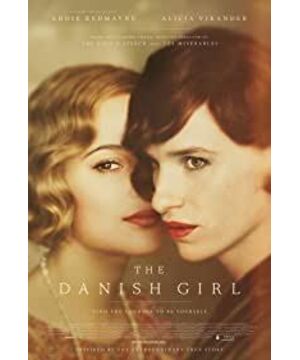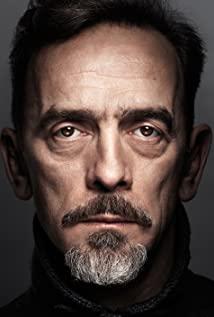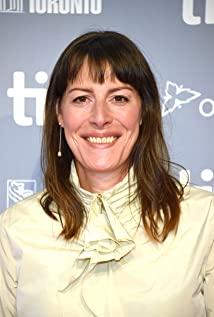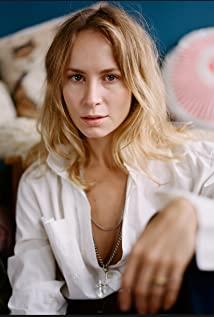I love the scene where he wakes up.
Because when a person just wakes up, he can best show his id. And you look at the way he sleeps, the arc of his arms bent under the pillow, the shape of his eyes squinting, and the way he smiles, all of which look like a girl.
His femininity is not abrupt.
Let's take a look at those beautiful pictures.
The film can be roughly divided into three parts, depending on the location.
The first part is in Copenhagen.
It's easy to spot the director's preference for women: whether it's Gerda or her best friend, it makes an already well-crafted set a little more elaborate. In particular, almost every scene in which the heroine appears can be cut into an oil painting.
The light on the left illuminates the light blue shirt dress on Gerda's body. The background wall is a little bit darker than the skirt, and the color and light are all echoed; The master is meticulous, and the paintings and sundries hanging on the right wall accentuate the emphasis.
And we have to notice that in this first part, the wall color of the two protagonists' homes is indigo blue, and the heroine's clothes often echo it, while Aina is often in black, which is abrupt and out of place with the color of the whole picture. .
This is presumably a way of implying that his inner and physical gender are not.
For example, in this picture, in contrast to the female protagonist, the male protagonist does not echo the color of the light, the bright sunshine makes him gloomy, and the half-closed door makes his mind more cramped.
You can easily see that he is lonely.
This is the lonely Aina walking the wide streets of Copenhagen.
In addition to blue, the director loves to use yellow. Looking at the picture above, a lot of yellow is used on the building, and on a slightly hazy morning, Lily came to find the artist. What about his outfit?
He's a little blue in yellow, he's already female at heart, and he's gloomy: on the one hand he can't get rid of the color of home and the guilt of Goddard - he's blue, on the other hand it's his female symbol of. It is through this contrast of colors that Aina's inner struggle in the act of going to the artist is revealed.
In the second part, in Paris, the heroine keeps trying to make him happy: she asks Aina to help her paint the background, but Aina walks away in despair.
Most of the scenes in Paris use luxurious yellow, and the heroine's clothes are also changed accordingly. As shown in the picture above, the patterns on her clothes match the curtains, and the sunlight illuminates her elegant face and neck. Only the male protagonist walking in the shadows turns away from the female protagonist, as well as the main theme and inner thoughts. He wants to be a woman, but can only live in the shadows.
Watch this scene again: Aina helps Goda make a canvas, and Goda says to meet with Hans. In fact, Aina has gradually integrated into this feminine melody: he wears a light blue shirt, and two paintings on the wall behind him, one left and one right, one side and one circle, are against him. From the characters to the ginger-colored curtains to the deep sunlight, the picture has a coherence of light and shade, and the balanced and slightly different scenery makes the picture come alive. Compared with the story of Copenhagen, Paris is by no means more vivid.
His heart is gradually accepting, instead of sneaking and hiding in Copenhagen.
So he's doing Lily more and more. Even when Aina's menswear appeared, he became more and more comfortable with the picture.
There is more and more yellow in the picture, and Aina is more and more pale yellow. He and the picture, that is, his inner thoughts, are becoming more and more harmonious. He's also getting more natural and determined - so later in the park he's recognized as a girl.
When he got on the train for surgery, the train that "take him to remove the disguise" was also bright yellow. The sun lit up the wall of the car, and the identification card in his hand.
At this moment, his outer shell is still male - dark blue, but his heart has been illuminated, the sun is shining on the birth certificate, and he will also remove his disguise and be reborn.
Wait until the scene switches to those shots in the hospital, because simplicity becomes more beautiful.
The light begins to soften. Facing this new-born operation, Aina put on a white surgical gown. He no longer struggled with the color and sunlight in his heart, but the surrounding environment was pushing and showing him. The patterns on both sides of the window outline his feminine beauty, and the motto on the wall seems to be his determination. Different from the gloominess of the first act, the splendid transformation of the second act, the third act shows the tranquility and faint joy of the new life.
In this scene, the doctor is holding Lily's hand, as if the weak Adam and the angel are holding hands. Yellow is now displayed in the form of lights and the color of Lily's clothes, no longer luxurious or bright, but solemn. Because the chance of restarting life uses life and death as a bargaining chip, and after Lily's previous transformation, what he longs for is to live as a woman, not just to live.
My favorite is this scene.
After the operation, Godard accompanied Lily out to bask in the sun.
Look, they are sitting at the junction of the flower gallery. They are both women, but they are coming from different directions. They are also two people who love each other, but they came together only after walking through a long corridor. Lily and Aina are wearing loose-fitting clothes in the same color. Time seemed quiet and beautiful.
Looking into the distance, that is, the future, it turns out that Lily and Aina are no different. They are holding hands, the sky is high and the earth is wide in front of them, and love flows into a river.
So even though Lily died in the end, I didn't feel sad. Her wish has been fulfilled, she has torn off her mask and became herself. Lily never wanted to live long, but to live as a woman. She did it, and it is considered that she has not lived through this life in vain.
In the end, Hans and Godard came to a high place to visit Lily who died. The sky and the earth are vast and the water is boundless. Lily doesn't need to color it anymore. beauty and freedom.
Beauty is enough for Lily, the Danish girl, and for The Danish Girl.
View more about The Danish Girl reviews











